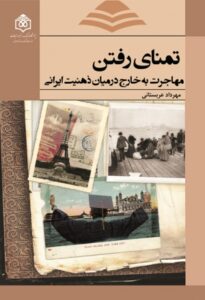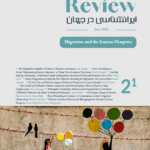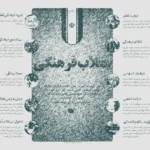/Book Review | Reading Time: 7 minutes
Longing to Leave
Migration in the Iranian Intersubjectivity
Leila Araghi | June, 2025

In his book, Longing to Leave: Migration in the Iranian Intersubjectivity, Mehrdad Arabestani explores migration as it is experienced mentally and culturally within Iranian society. He seeks to problematize the ways Iranians comprehend the concept of “migration” in their intersubjective mentality. H
He begins with the widespread nature of the desire to emigrate and cites various statistics to highlight its prevalence among the population. He cites statistics that show Iran appears alongside Afghanistan, Iraq, Syria, and Pakistan, the countries ranked among the major refugee-sending countries in 2016 due to war and other crises. His references include the high rate of participation of Iranians in the U.S. Diversity Visa Lottery and 2014 National Survey of Social Capital in Iran, whose data underscore the importance of migration in Iranians’ life plans.
Following the introduction, the author focuses on how a shared understanding of migration and its destinations has taken shape as an intersubjective perception within Iranian society. He does not consider mentality and intersubjectivity to be merely the result of indoctrination or propaganda; rather, he regards them as the society’s ultimate interpretation of all structural conditions—economic, political, and cultural (2018: 19). His book raises two central questions: (1) What categories and themes have shaped Iranian intersubjective understandings of the causes of migration? and (2) How are these categories and themes embedded in, and interpreted through, broader social, discursive, and identity-based contexts? (Ibid: 21) To answer these questions, he develops his arguments through eight chapters, a conclusion, and appendices. The first chapter begins with defining the theoretical concepts and his research methods, while chapters Two and Three trace how migration is framed as a structured cultural desire that informs individuals’ migration decisions. Across Chapters Four to Eight, the author unpacks how his interlocutors grapple with this desire, classifying their responses into thematic categories: ‘Escaping,’ ‘Moral Concerns,’ ‘Staying,’ and ‘Returning.’
We learn from the first chapter that the author adopts an ethnographic and qualitative methodological approach, grounded in engaging with people through informal conversations and immersing in their lived experiences. His research builds on his observations of students’ decision-making processes regarding their futures, drawn from his experience as a professor at the Faculty of Social Sciences at the University of Tehran. This is further enriched by focus group discussions with students from the same university, as well as in-depth interviews with 60 individuals from diverse social backgrounds, life experiences, and widely varying future aspirations. The first chapter also introduces the conceptual framework of The Longing to Leave as anthropological research informed by studies of subjectivity and social psychology. Arabestani argues that intersubjectivity represents a collective phenomenon: a shared framework shaped by the overarching interpretation of structural conditions that gives rise to collective identity. Subjectivity, by comparison, is individual and rooted in personal history.
Drawing on Freud’s Civilization and Its Discontents and the concept of the libidinal economy in Chapters Two and Three, the author introduces the notion of a “depriving society”—a society in which the balance between imposed deprivations (such as discipline and order) and the compensatory rewards offered to individuals has broken down, resulting in a pervasive cultural malaise. This imbalance results in a pervasive cultural malaise. He contends that his research into participants’ aspirations and desires shows how migration has come to define a key element of middle-class cultural identity in Tehran.
Arabestani also draws on Lacan’s theoretical elaborations of the constitution of the “subject” in relation to the symbolic “Other” – which could be a symbolic system or fantasy rather than a specific person – to conclude that self-consciousness requires recognition by the Other. Referring to Lacan’s four discourses of Master, University, Hysteric, and Analyst, he reminds us that the subject is positioned differently in each of these discourses (Ibid: 41). He inserts that “the cluster of signifiers with which a subject identifies is determined by the nature of their desire and the lack they attempt to resolve.” (Ibid: 47)
Using these conceptual lens to explore the intersubjectivity, Arabestani examines the migration discourse in Iran and its interactions with the mainstream “political subjectivity” shaped by socio- cultural, power structures (Ibid: 56). He suggests that the assumptions underlying the common question posed to returnees—those who have lived abroad—“Why did you come back?” reflect this form of political subjectivity. This question presumes that staying abroad is inherently a marker of success, while returning demands explanation or justification.
Drawing from his research, he suggests that the word kharej (abroad), as used in everyday social interactions in Iran, connotes freedom and rationality—qualities that are commonly perceived as lacking or denied to Iranians. It does not point to a specific geographical location but functions as an empty or floating signifier onto which individuals project their aspirations. This experience of “lack,” deeply embedded in Iran’s historical and social context, influences how individuals live and make sense of their world, whether they choose to leave or stay. (Ibid: 68).
Through an analysis of the conflicting impulses to stay or leave, and the intersubjective dimensions of these desires, Arabestani identifies five dominant configurations: (1) the desire to migrate, (2) escape, (3) moral dilemmas, (4) staying, and (5) returning. He analyzes his data across Chapters Four to Eight, each organized around these situational themes, to explore the range of desires expressed by his participants. He concludes that the desire to migrate reflects a yearning to escape social pressures embedded in Iranian intersubjectivity—a longing to live in a place perceived as offering dignity and respect. This sense of deprivation and constraint is contrasted with feelings of liberation and the imagined experience of the world and its possibilities. The belief that any foreign society is inherently superior—more rational, freer, and more livable than “here”—combined with the desire to identify with a global culture, underpins the binary opposition between deprivation and liberation.
The research emphasizes a complex web of factors which shape the desire to escape from Iran, among them the will to grasp better life opportunities somewhere else is the key driver. This is particularly true for the social groups that are marginalized by legal and ideological discrimination. According to the author, unfulfilled desires place the subject in a state of persistent dissatisfaction and loss. Here, Lacan’s Hysterical discourse emerges–the discourse of the complaining, dissatisfied subject who addresses the Master discourse, which is in ruling position and demands that the subject to align with a given identity. The subject’s unmet desires and sense of deprivation and failure reinforce the perception that they have not (and do not) enjoyed adequate life chances, leading them to begin identifying with an imagined ideal life” (ibid: 108–124).
In the final chapters, Arabestani briefly explores the themes of “Staying” and “Returning.” In the “Staying” section, the author analyzes those who, despite their desire to leave, have made the decision to stay. They often cite personal, cultural, or familial reasons, along with an investment in national identity—sometimes even framing their decision as a conscious act of resistance against the dominant trend of migration. In the chapter focused on “Returning”, the narratives of those who, through their act of coming back, construct a binary experience of migration are discussed. Returnees often cite factors such as disillusionment with foreign societies, cultural differences, homesickness, and confronting a “nowhere land” (nakoja-ābād) as influential in their decision to return. Thus, from the author’s perspective, migration is not merely an act of escape but, at times, becomes a cyclical process. He emphasizes that national identity–shaped by shared history and collective experience–carries different emotional weights for different individuals. For some, turning away from it is akin to turning away from the country itself and from those who have sacrificed to preserve and sustain it. Arabestani interprets these sentiments as expressions of patriotism. He views the illusion of migration as stemming from an improbable fantasy, one constructed and reinforced by narratives, media, and propaganda–fantasies that manipulate individual imaginations to construct an altered sense of reality.
Although Longing to Leave focuses on the ethnography of migration desires among a group of young people in Tehran, the author considers his findings more or less true about broader Iranian society. The claim cannot be fairly assessed, as there is a limited body of academic research on the cultural and subjective dimensions of migration within Iran’s social science scholarship. The claim that Iran ranks alongside war-torn Middle Eastern countries in producing migrants also remains unverified. In fact, conducting a comparative analysis between Iran and countries such as Turkey would be more useful in determining whether migration from Iran is exceptional or aligns with patterns observed in demographically similar countries. However, two other studies (Salavati & Maleki, 2018; Asayesh, 2018 & 2024) support the argument that migration has become a natural decision in the lives of many young Iranians.
As a final point, Longing to Leave is an innovative book that contributes to our understanding of migration subjectivity in Iran by applying the theories of Freud and Lacan, opening new avenues for future research on the psychological and sociological dimensions of migration in the country. However, the chapters on “staying” and “returning” are relatively brief and could benefit from a deeper analysis. These chapters would be strengthened by a clearer, more comprehensive examination—both quantitative and structural—of how these trends influence the migration cycle in Iran. The author overlooks the perspective that migration might, for some people, be less about permanent relocation and more about “seeing the world” and choosing a place to settle afterward. It could explain why he treats “staying” as a marginal pattern while for some, migration is experienced as a journey of self-discovery through encounters with the Other—a journey that feels complete only upon return. Although there is no precise data on the number of dual-national Iranians residing in Iran, their presence is substantial enough for issues related to their civic rights to occasionally surface in public and media discourse. A notable example is Canada’s evacuation of 15,000 Lebanese-Canadians during the 2006 war—one of the country’s largest operations of its kind—which sparked public debate in Canadian media around the notion of “convenience migration.”
Arabestani’s conceptualization of “patriotism” remains somewhat vague, which weakens his argument. While he uses the term to describe the sense of belonging among those who choose to stay, his framing lacks clarity and depth. The book does not sufficiently explore the emotional shift from belonging to detachment, nor does it consider how living in an exclusionary or depriving society might transform one’s feelings toward the homeland. Additionally, the absence of a demographic overview of the research participants limits the reader’s ability to fully grasp key “how” and “why” questions raised throughout the book.










Comments are closed.